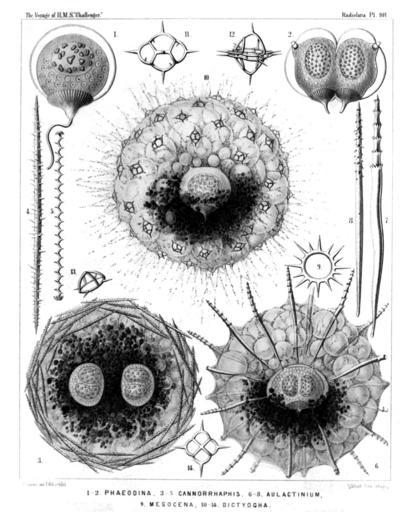MAKE A MEME
View Large Image

| View Original: | Radiolaria_(Challenger)_Plate_101.jpg (2560x3200) | |||
| Download: | Original | Medium | Small | Thumb |
| Courtesy of: | commons.wikimedia.org | More Like This | ||
| Keywords: Radiolaria (Challenger) Plate 101.jpg follows <table> <tr> <td style text-align center; vertical-align top; colspan 3 >Plate 101 Phæodinida Cannorrhaphida et Aulacanthida </td> </tr> <tr> <td style font-size 85 ; text-align right; vertical-align top; colspan 3 >Diam </td> </tr> <tr> <td style vertical-align top; >Fig 1 Phæocolla primordialis n sp </td> <td style vertical-align bottom; >×</td> <td style text-align right; vertical-align bottom; >300</td> </tr> <tr> <td style font-size 85 ; padding-left 3em; text-indent -1em; vertical-align top; >Central capsule isolated The double contoured outer mmbrane exhibits only one opening with a radiate operculum and long proboscis The granular protoplasm encloses clear spherical vacuoles The sphæroidal nucleus contains irregular amœboid nucleoli </td> </tr> <tr> <td style vertical-align top; >Fig 2 Phæodina tripylea n sp </td> <td style vertical-align bottom; >×</td> <td style text-align right; vertical-align bottom; >300</td> </tr> <tr> <td style font-size 85 ; padding-left 3em; text-indent -1em; vertical-align top; >A central capsule in self-division with two elliptical nuclei The astropyle is already bisected and has two proboscides </td> </tr> <tr> <td style vertical-align top; >Fig 3 Cannorrhaphis spinulosa n sp </td> <td style vertical-align bottom; >×</td> <td style text-align right; vertical-align bottom; >300</td> </tr> <tr> <td style font-size 85 ; padding-left 3em; text-indent -1em; vertical-align top; >A complete specimen with two central capsules each of which contains two nuclei The alveolate calymma contains a dark phæodium and is surrounded by tangential tubular needles </td> </tr> <tr> <td style vertical-align top; >Fig 4 Cannorrhaphis spinulosa n sp </td> <td style vertical-align bottom; >×</td> <td style text-align right; vertical-align bottom; >300</td> </tr> <tr> <td style font-size 85 ; padding-left 3em; text-indent -1em; vertical-align top; >A single tangential tube </td> </tr> <tr> <td style vertical-align top; >Fig 5 Cannorrhaphis spathillata n sp </td> <td style vertical-align bottom; >×</td> <td style text-align right; vertical-align bottom; >300</td> </tr> <tr> <td style font-size 85 ; padding-left 3em; text-indent -1em; vertical-align top; >A single tangential tube </td> </tr> <tr> <td style vertical-align top; >Fig 6 Aulactinium actinastrum n sp </td> <td style vertical-align bottom; >×</td> <td style text-align right; vertical-align bottom; >100</td> </tr> <tr> <td style font-size 85 ; padding-left 3em; text-indent -1em; vertical-align top; >A complete specimen seen in optical meridional section In the centre the spheroidal central capsule with its double membrane and three openings above two lateral parapylæ below the large astropyle with its radiate operculum The capsule encloses numerous spherical vacuoles and two hemispherical nuclei each with numerous nucleoli The anterior half of the capsule is surrounded by the blackish phæodium The spherical calymma contains numerous globular alveoles and is pierced by the radial tubes the proximal ends of which are in contact with the surface of the central capsule compare Pl 103 fig 1 </td> </tr> <tr> <td style vertical-align top; >Fig 7 Aulactinium actinastrum n sp </td> <td style vertical-align bottom; >×</td> <td style text-align right; vertical-align bottom; >300</td> </tr> <tr> <td style font-size 85 ; padding-left 3em; text-indent -1em; vertical-align top; >A single radial tube </td> </tr> <tr> <td style vertical-align top; >Fig 8 Aulactinium actinelium n sp </td> <td style vertical-align bottom; >×</td> <td style text-align right; vertical-align bottom; >200</td> </tr> <tr> <td style font-size 85 ; padding-left 3em; text-indent -1em; vertical-align top; >A single radial tube </td> </tr> <tr> <td style vertical-align top; >Fig 9 Mesocena stellata n sp </td> <td style vertical-align bottom; >×</td> <td style text-align right; vertical-align bottom; >600</td> </tr> <tr> <td style font-size 85 ; padding-left 3em; text-indent -1em; vertical-align top; >A single annular piece of the skeleton</td> </tr> <tr> <td style vertical-align top; >Fig 10 Dictyocha stapedia n sp </td> <td style vertical-align bottom; >×</td> <td style text-align right; vertical-align bottom; >300</td> </tr> <tr> <td style font-size 85 ; padding-left 3em; text-indent -1em; vertical-align top; >A complete specimen observed living at Ceylon In the centre is visible the large spheroidal tripylean central capsule with its three openings containing a large nucleus with numerous nucleoli Its oral half is covered with the dark phæodium The voluminous spherical calymma contains numerous globular alveoles and its surface is covered with scattered stirrup-shaped pieces of the skeleton Numerous free pseudopodia arise from the surface </td> </tr> <tr> <td style vertical-align top; >Fig 11 Dictyocha stapedia n sp </td> <td style vertical-align bottom; >×</td> <td style text-align right; vertical-align bottom; >800</td> </tr> <tr> <td style font-size 85 ; padding-left 3em; text-indent -1em; vertical-align top; >A single piece of the skeleton from above </td> </tr> <tr> <td style vertical-align top; >Fig 12 Dictyocha stapedia n sp </td> <td style vertical-align bottom; >×</td> <td style text-align right; vertical-align bottom; >800</td> </tr> <tr> <td style font-size 85 ; padding-left 3em; text-indent -1em; vertical-align top; >A twin piece of the skeleton </td> </tr> <tr> <td style vertical-align top; >Fig 13 Dictyocha medusa n sp </td> <td style vertical-align bottom; >×</td> <td style text-align right; vertical-align bottom; >800</td> </tr> <tr> <td style font-size 85 ; padding-left 3em; text-indent -1em; vertical-align top; >A single piece of the skeleton from the side </td> </tr> <tr> <td style vertical-align top; >Fig 14 Dictyocha medusa n sp </td> <td style vertical-align bottom; >×</td> <td style text-align right; vertical-align bottom; >800</td> </tr> <tr> <td style font-size 85 ; padding-left 3em; text-indent -1em; vertical-align top; >A single piece of the skeleton from above </td> </tr> </table> https //archive org/details/reportonradiolar00haecrich 1887 Ernst Haeckel 1834-1919 ; engravings by Adolf Giltsch 1852-1911 PD-old-auto-1923 1919 Report on the Radiolaria | ||||